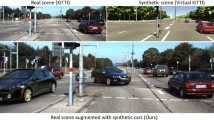Abstract
This paper presents a generative model for the creation of large synthetic image datasets. The model is implemented as a 3D scene, representing an urban environment, in Blender. The images are rendered using the Cycles rendering engine which allows for the creation of high-fidelity data. During the process of image rendering, the data was automatically labeled for the purpose of distance estimation. The process of data labeling was achieved by extracting object metadata from the 3D scene, allowing for the generative model to be reconfigured to generate datasets for other purposes such as classification, object detection, semantic segmentation, etc. The data acquired in the manner described previously was used for the end-to-end training of a convolutional neural network, designed to estimate distance from stereoscopic images. Evaluation of the neural network’s performance showed that the generative model presented in this paper is viable for the generation of large image datasets for the training of predictive models, eliminating the need for time-consuming manual data acquisition and labeling.
Access this chapter
Tax calculation will be finalised at checkout
Purchases are for personal use only
Similar content being viewed by others
References
Alzantot, M., Chakraborty, S., Srivastava, M.: Sensegen: a deep learning architecture for synthetic sensor data generation. In: 2017 IEEE International Conference on Pervasive Computing and Communications Workshops (PerCom Workshops). IEEE, pp. 188–193 (2017)
Areann, M.C., Bosch, T., Lescure, M., et al.: Laser ranging: a critical review of usual techniques for distance measurement [j]. Opt. Eng. 40 (2001)
Barua, S., M., Islam, M., Murase, K.: A novel synthetic minority oversampling technique for imbalanced data set learning. In: International Conference on Neural Information Processing. Springer, Berlin, pp. 735–744 (2011)
Chernyshova, Y.S., Gayer, A.V., Sheshkus, A.V.: Generation method of synthetic training data for mobile OCR system. In: 10th International Conference on Machine Vision (ICMV 2017). International Society for Optics and Photonics, SPIE, vol. 10696, pp. 640–646 (2018)
Community, B.O.: Blender—a 3D Modelling and Rendering Package. Blender Foundation, Stichting Blender Foundation, Amsterdam (2018)
Falkenhagen, L.: Depth estimation from stereoscopic image pairs assuming piecewise continuos surfaces. In: Image Processing for Broadcast and Video Production. Springer, Berlin, pp. 115–127 (1995)
Geiger, A., Lenz, P., Stiller, C., Urtasun, R.: Vision meets robotics: the Kitti dataset. Int. J. Robot. Res. (IJRR) 32, 1231–1237 (2013)
Heinzler, R., Schindler, P., Seekircher, J., Ritter, W., Stork, W.: Weather influence and classification with automotive lidar sensors. In: 2019 IEEE Intelligent Vehicles Symposium (IV). IEEE, pp. 1527–1534 (2019)
Kniaz, V., Gorbatsevich, V., Mizginov, V.: Thermalnet: a deep convolutional network for synthetic thermal image generation. In: The International Archives of Photogrammetry, Remote Sensing and Spatial Information Sciences, pp. 41–45 (2017)
Lim, B., Woo, T., Kim, H.: Integration of vehicle detection and distance estimation using stereo vision for real-time aeb system. VEHITS, pp. 211–216 (2017)
Lin, T.Y., Maire, M., Belongie, S., Hays, J., Perona, P., Ramanan, D., Dollár, P., Zitnick, C.L.: Microsoft coco: common objects in context. In European conference on computer vision. Springer, Berlin, pp. 740–755 (2014)
Mahjourian, R., Wicke, M., Angelova, A.: Unsupervised learning of depth and ego-motion from monocular video using 3d geometric constraints. In: Proceedings of the IEEE Conference on Computer Vision and Pattern Recognition, pp. 5667–5675 (2018)
O’ Shea, R.P., Blackburn, S.G., Ono, H.: Contrast as a depth cue. Vis. Res. 34(12), 1595–1604 (1994)
Planche, B., Wu, Z., Ma, K., Sun, S., Kluckner, S., Lehmann, O., Chen T., Hutter, A., Zakharov, S., Kosch, H., et al.: Depthsynth: real-time realistic synthetic data generation from cad models for 2.5 d recognition. In: 2017 International Conference on 3D Vision (3DV). IEEE, pp. 1–10 (2017)
Ros, G., Sellart, L., Materzynska, J., Vazquez, D., Lopez, A.M.: The synthia dataset: a large collection of synthetic images for semantic segmentation of urban scenes. In: Proceedings of the IEEE Conference on Computer Vision and Pattern Recognition (CVPR) (2016)
Rosu, R.A., Behnke, S.: Easypbr: a lightweight physically-based renderer (2020)
Smolyanskiy, N., Kamenev, A., Birchfield, S.: The importance of stereo for accurate depth estimation: an efficient semi-supervised deep neural network approach (2020)
Tripathi, S., Chandra, S., Agrawal, A., Tyagi, A., Rehg, J.M., Chari, V.: Learning to generate synthetic data via compositing. In: Proceedings of the IEEE Conference on Computer Vision and Pattern Recognition, pp. 461–470 (2019)
Troscianko, T., Montagnon, R., Le Clerc, J., Malbert, E., Chanteau, P.L.: The role of colour as a monocular depth cue. Vis. Res. 31(11), 1923–1929 (1991)
Tsirikoglou, A., Kronander, J., Wrenninge, M., Unger, J.: Procedural modeling and physically based rendering for synthetic data generation in automotive applications. arXiv: 1710.06270 (2017)
Wang, C., Miguel Buenaposada, J., Zhu, R., Lucey, S.: Learning depth from monocular videos using direct methods. In: Proceedings of the IEEE Conference on Computer Vision and Pattern Recognition, pp. 2022–2030 (2018)
Zhang, Y., Song, S., Yumer, E., Savva, M., Lee, J.Y., Jin, H., Funkhouser, T.: Physically-based rendering for indoor scene understanding using convolutional neural networks (2017)
Acknowledgements
This research was supported by the Science Fund of the Republic of Serbia, #GRANT No. 65241005, AI—ATLAS.
Author information
Authors and Affiliations
Corresponding author
Editor information
Editors and Affiliations
Rights and permissions
Copyright information
© 2021 The Author(s), under exclusive license to Springer Nature Switzerland AG
About this chapter
Cite this chapter
Nešić, N., Vidović, M., Radosavljević, I., Mitrović, A., Obradović, Đ. (2021). A Generative Model for the Creation of Large Synthetic Image Datasets Used for Distance Estimation. In: Pap, E. (eds) Artificial Intelligence: Theory and Applications. Studies in Computational Intelligence, vol 973. Springer, Cham. https://doi.org/10.1007/978-3-030-72711-6_15
Download citation
DOI: https://doi.org/10.1007/978-3-030-72711-6_15
Published:
Publisher Name: Springer, Cham
Print ISBN: 978-3-030-72710-9
Online ISBN: 978-3-030-72711-6
eBook Packages: Intelligent Technologies and RoboticsIntelligent Technologies and Robotics (R0)




